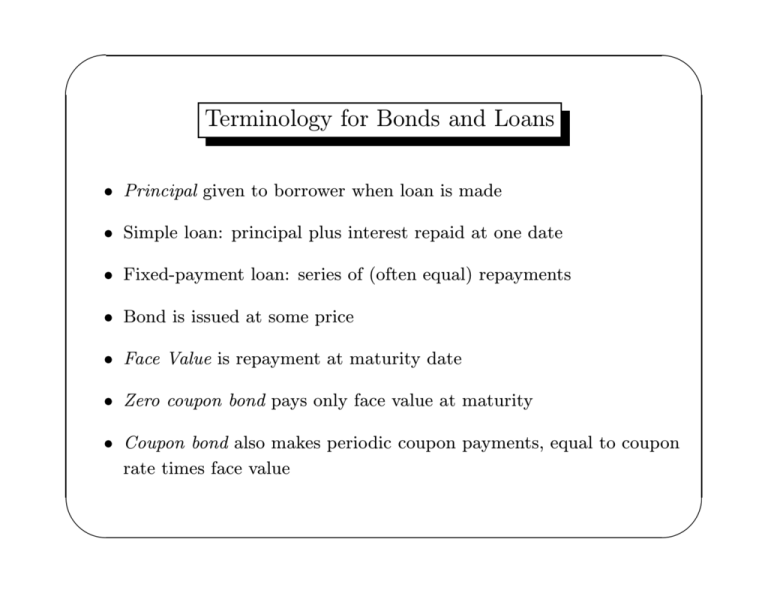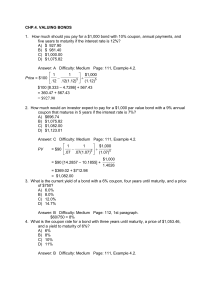
'
Terminology for Bonds and Loans
$
• Principal given to borrower when loan is made
• Simple loan: principal plus interest repaid at one date
• Fixed-payment loan: series of (often equal) repayments
• Bond is issued at some price
• Face Value is repayment at maturity date
&
• Zero coupon bond pays only face value at maturity
• Coupon bond also makes periodic coupon payments, equal to coupon
rate times face value
%
Compounding
• Assume that the interest rate is 10% p.a.
• What this means is that if you invest $1
for one year, you have been promised
$1*(1+10/100) or $1.10 next year
• Investing $1 for yet another year
promises to produce 1.10 *(1+10/100)
or $1.21 in 2-years
Value of $5 Invested
• More generally, with an investment of $5
at 10% we obtain
1 Year
$5*(1+0.10)
$5.5
2 years
$5.5*(1+0.10)
$6.05
3 years
$6.05*(1+0.10)
$6.655
4 Years $6.655*(1+0.10)
$7.3205
Future Value of a Lump Sum
FV = PV * (1 + i )
n
F V w ith gro w th s fro m -6 % to +6 %
3 ,5 0 0
6%
Future Value of $1000
3 ,0 0 0
2 ,5 0 0
4%
2 ,0 0 0
1 ,5 0 0
2%
1 ,0 0 0
0%
-2 %
-4 %
-6 %
500
0
0
2
4
6
8
10
Y ea rs
12
14
16
18
20
Generalizing the method
• Generalizing the method requires some
definitions. Let
– i be the interest rate
– n be the life of the lump sum investment
– PV be the present value
– FV be the future value
Example: Future Value of a
Lump Sum
• Your bank offers a
CD with an interest
rate of 3% for a 5
year investment.
• You wish to invest
$1,500 for 5 years,
how much will your
investment be
worth?
FV = PV * (1 + i ) n
= $ 1500 * (1 + 0 .03 ) 5
= $ 1738 .1111145
n
i
PV
FV
Result
5
3%
1,500
?
1738.911111
Present Value of a Lump Sum
FV = PV * (1 + i )
n
Divide both sides by (1 + i ) to obtain :
n
FV
−n
PV =
= FV * (1 + i )
n
(1 + i )
Example: Present Value of a
Lump Sum
• You have been
offered $40,000 for
your printing
business, payable in
2 years. Suppose
the interest rate is
8%. What is the
present value of the
offer?
FV
PV =
(1 + i ) n
40,000
=
(1 + 0.08) 2
= 34293.55281
≅ $34,293.55 today
Solving Lump Sum Cash Flow
for Interest Rate
FV = PV * (1 + i ) n
FV
= (1 + i ) n
PV
FV
n
(1 + i ) =
PV
FV
−1
i=n
PV
'
Calculations for Bonds and Loans
$
Interest rate i is yield to maturity.
n is time to maturity
• Simple Loans: use lump sum formula; PV = principal; FV =
principal plus interest.
• Zero Coupon Bonds: use lump sum formula; PV = price; FV =
face value.
&
• Fixed-Payment Loans: use annuity formula; pmt = loan
payment; PV = principal
• Coupon Bonds: combine annuity and lump sum formulas. With
%
'
$
face value F and coupon payment C, the price p is equal to
P =
&
C
C
C
F
C
+
+
...
+
+
+
1 + i (1 + i)2
(1 + i)n
(1 + i)n
(1 + i)n
%
Example: Interest Rate on a
Lump Sum Investment
• If you invest $15,000 for
ten years, you receive
$30,000. What is your i = n FV − 1
PV
annual return?
1
30000
10
10
• Other interpretation: if
= 10
−1 = 2 −1 = 2 −1
15000
price of 10 year bond
with face value 30,000 is = 0.071773463
15,000, then interest rate = 7.18% (to the nearest basis point)
(yield to maturity) on
bond is 7.18%
Yield to Maturity: Loans
Yield to maturity = interest rate that equates today’s value with
present value of all future payments
1. Simple Loan (i = 10%)
$100 = $110/(1 + i) ⇒
i=
$110 – $100
$100
=
$10
$100
= 0.10 = 10%
2. Fixed Payment Loan (i = 12%)
$1000 =
LV =
$126
(1+i)
FP
(1+i)
+
+
$126
(1+i)2
FP
(1+i)2
+
+
$126
(1+i)3
FP
(1+i)3
+ ... +
+ ... +
$126
(1+i)25
FP
(1+i)n
Yield to Maturity: Bonds
3. Coupon Bond (Coupon rate = 10% = C/F)
P=
$100
$100
+
+
(1+i)
(1+i)2
$100
$100
$1000
+
...
+
+
(1+i)3
(1+i)10
(1+i)10
P=
C
(1+i)
C
C
F
+
...
+
+
(1+i)3
(1+i)n
(1+i)n
+
C
+
(1+i)2
Consol: Fixed coupon payments of $C forever
C
C
i =
i
P
4. Discount Bond (P = $900, F = $1000), one year
P=
$900 =
$1000
(1+i)
i=
$1000 – $900
$900
i=
F–P
P
⇒
= 0.111 = 11.1%
Relationship Between Price
and Yield to Maturity
Three Interesting Facts in Table 1
1. When bond is at par, yield equals coupon rate
2. Price and yield are negatively related
3. Yield greater than coupon rate when bond price is below par value
© 2004 Pearson Addison-Wesley. All rights reserved
4-5
'
Bond Yields and Bond Prices
$
• yield to maturity on a coupon bond cannot be calculated
analytically; need computer or financial calculator
• YTM high if bond price is low
• YTM equals coupon rate if bond price equals face value (bond
trades at par)
• YTM higher (lower) than coupon rate if bond price lower
(higher) than face value
&
• current yield (coupon rate/price) is approximation to YTM;
works well if long maturity, bond trades close to par.
%
The Problem
How much will I have available in
my retirement account if I deposit
$2,000 per year into an IRA that
pays on average 16% per year if I
plan to retire in 40 years time?
Annuity
= Stream of Cash Flows, such that
– the first cash flow will occur exactly one
period form now
– all subsequent cash flows are separated by
exactly one period
– all periods are of equal length
– the interest rate is constant
– all cash flows have the same value
Annuity Formula Notation
• PV = the present value of the annuity
• i = interest rate to be earned over the
life of the annuity
• n = the number of payments
• pmt = the periodic payment (cash flow)
Derivation of PV of Annuity
Formula
pmt
pmt
PV =
+
+
1
2
(1 + i ) (1 + i )
pmt
pmt
pmt
+Λ +
+
3
n −1
n
(1 + i )
(1 + i )
(1 + i )
PV of Annuity Formula
pmt *{1 −
PV =
1
}
n
(1 + i )
i
1
pmt
=
* 1 −
n
i (1 + i )
PV Annuity Formula: Payment
1
pmt
* 1 −
PV =
n
i (1 + i )
(
pmt
−n
* 1 − (1 + i )
=
i
PV * i
pmt =
−n
1 − (1 + i )
(
)
)
Derivation of FV of Annuity
Formula: Algebra
pmt
1
(reg. annuity)
PV =
* 1 −
n
i (1 + i )
FV = PV * (1 + i ) (lump sum)
n
pmt
1
n
i
(
)
FV =
* 1 −
*
1
+
i (1 + i )n
(
)
pmt
n
* (1 + i ) − 1
=
i
FV Annuity Formula: Payment
(
)
pmt
n
FV =
* (1 + i ) − 1
i
FV * i
pmt =
(1 + i )n − 1
(
)
Data for Problem
– I = 16%
– n = 40
– Pmt = $2,000
– FV = ?
Solution
(
)
pmt
n
(1 + i ) − 1
F =
i
2000
40
(1 + 0 .16 ) − 1
=
0 . 16
= $ 4 ,721 ,514 . 481
(
)









